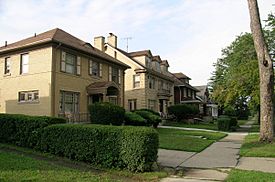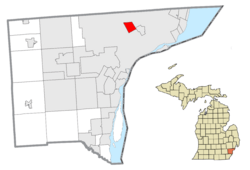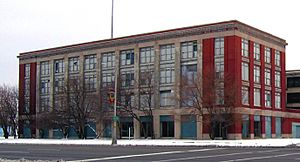Highland Park, Michigan facts for kids
Quick facts for kids
Highland Park, Michigan
|
|
|---|---|

Medbury's–Grove Lawn Subdivisions Historic District along Puritan Avenue
|
|

Location of Highland Park in Wayne County, Michigan
|
|
| Country | United States |
| State | Michigan |
| County | Wayne |
| Settled | 1825 |
| Founded | 1889 |
| Incorporated (village) | 1889 |
| Incorporated (town) | 1890 |
| Incorporated (city) | 1918 |
| Government | |
| • Type | Mayor–council |
| Area | |
| • Total | 2.971 sq mi (7.695 km2) |
| • Land | 2.971 sq mi (7.695 km2) |
| • Water | 0.000 sq mi (0.000 km2) |
| Elevation | 637 ft (194 m) |
| Population
(2020)
|
|
| • Total | 8,977 |
| • Estimate
(2023)
|
8,443 |
| • Density | 2,840/sq mi (1,097/km2) |
| Time zone | UTC−5 (Eastern (EST)) |
| • Summer (DST) | UTC−4 (EDT) |
| ZIP Code |
48203
|
| Area code(s) | 313 |
| FIPS code | 26-38180 |
| GNIS feature ID | 0628251 |
| Sales tax | 6.0% |
Highland Park is a city in Wayne County, Michigan. It's like a small island city completely surrounded by Detroit. Highland Park is about 6 miles (10 km) north of Downtown Detroit. In 2020, about 8,977 people lived there.
Contents
History of Highland Park
Early Days and Founding
Highland Park started as a small farming area. It was located on a high ridge where Woodward Avenue and Highland Street are today. This spot was about 6 miles (10 km) north of Detroit.
In 1818, a famous Detroit judge named Augustus B. Woodward bought this land. He tried to create a village called Woodwardville in 1825, but it didn't work out. Another judge, Benjamin F. H. Witherell, also tried to start a village called Cassandra in 1836, but that failed too.
By 1860, the settlement got a post office and was called Whitewood. After some changes, it officially became a village named Highland Park in 1889.
The Automobile Boom
A big change happened in 1907 when Henry Ford bought 160 acres (65 ha) of land. He wanted to build an automobile plant there. The Highland Park Ford Plant was finished in 1909.
In 1913, the plant opened its first assembly line, which made cars much faster. This caused the population of Highland Park to grow very quickly. To protect its tax money from Detroit's growing borders, Highland Park became a city in 1918.
Between 1910 and 1920, Highland Park's population jumped from 4,120 to about 46,500! This was a huge increase because of the car industry.
In 1925, Chrysler Corporation was founded in Highland Park. They bought a local car plant and made it their main office for the next 70 years.
Later Challenges
In 1944, the Davison Freeway opened. It was the country's first modern highway built below ground level, and it ran right through the city.
In the late 1950s, Ford Motor Company tore down large parts of its Highland Park plant. As jobs were lost, the city faced problems like a shrinking population and less tax money. Ford stopped making tractors at the plant in 1973, and the whole property was sold in 1981.
Chrysler, the city's last big employer, moved its main office from Highland Park to Auburn Hills between 1991 and 1993. This move meant about 6,000 jobs left the city.
Highland Park was once known as "The City of Trees" because it had so many trees. But in the 1970s, a disease called Dutch elm disease caused many old trees to be cut down.
From 2001 to 2009, the state of Michigan had to help manage the city's money because of financial problems.
In 2011, Highland Park had to remove more than two-thirds of its streetlights. This was because the city couldn't pay its electric bill. A group called Soulardarity was later formed to bring back streetlights using solar street lights.
In 2013, the Detroit Water and Sewerage Department sued Highland Park over unpaid water bills. The two cities settled the issue in 2020.
Geography
Highland Park covers about 2.971 square miles (7.695 km²) of land. It's located about 6 miles (10 km) north of Downtown Detroit.
The city has clear boundaries:
- To the north: McNichols Road (also called 6 Mile Road)
- To the east: The Grand Trunk Western Railroad tracks
- To the south: The alleys of Tuxedo and Tennyson streets
- To the west: The Lodge Freeway and Thompson Street
Population and People
| Historical population | |||
|---|---|---|---|
| Census | Pop. | %± | |
| 1900 | 427 | — | |
| 1910 | 4,120 | 864.9% | |
| 1920 | 46,499 | 1,028.6% | |
| 1930 | 52,959 | 13.9% | |
| 1940 | 50,810 | −4.1% | |
| 1950 | 46,393 | −8.7% | |
| 1960 | 38,063 | −18.0% | |
| 1970 | 35,444 | −6.9% | |
| 1980 | 27,909 | −21.3% | |
| 1990 | 20,121 | −27.9% | |
| 2000 | 16,746 | −16.8% | |
| 2010 | 11,776 | −29.7% | |
| 2020 | 8,977 | −23.8% | |
| 2023 (est.) | 8,443 | −28.3% | |
| U.S. Decennial Census 2020 Census |
|||
Population in 2020
| Race / Ethnicity (NH = Non-Hispanic) | Pop 1980 | Pop 1990 | Pop 2000 | Pop 2010 | Pop 2020 | % 1980 | % 1990 | % 2000 | % 2010 | % 2020 |
|---|---|---|---|---|---|---|---|---|---|---|
| White alone (NH) | 3,937 | 1,271 | 668 | 347 | 484 | 14.11% | 6.32% | 3.99% | 2.95% | 5.39% |
| Black or African American alone (NH) | 23,300 | 18,594 | 15,598 | 10,955 | 7,876 | 83.49% | 92.41% | 93.14% | 93.03% | 87.74% |
| Native American or Alaska Native alone (NH) | 86 | 33 | 39 | 26 | 34 | 0.31% | 0.16% | 0.23% | 0.22% | 0.38% |
| Asian alone (NH) | 113 | 50 | 41 | 46 | 47 | 0.40% | 0.25% | 0.24% | 0.39% | 0.52% |
| Pacific Islander alone (NH) | 28 | N/A | 3 | 3 | 3 | 0.10% | N/A | 0.02% | 0.03% | 0.03% |
| Some Other Race alone (NH) | 213 | 36 | 29 | 14 | 46 | 0.76% | 0.18% | 0.17% | 0.12% | 0.51% |
| Mixed Race or Multi-Racial (NH) | N/A | N/A | 273 | 229 | 312 | N/A | N/A | 1.63% | 1.94% | 3.48% |
| Hispanic or Latino (any race) | 232 | 137 | 95 | 156 | 175 | 0.83% | 0.68% | 0.57% | 1.32% | 1.95% |
| Total | 27,909 | 20,121 | 16,746 | 11,776 | 8,977 | 100.00% | 100.00% | 100.00% | 100.00% | 100.00% |
In 2020, there were 8,977 people living in Highland Park. Most people (88.2%) were African American. About 5.7% were White.
About 19.3% of the people were under 18 years old. Also, 23.8% were 65 years or older.
Population in 2010
In 2010, Highland Park had 11,776 people. The population was mostly African American (93.5%).
About 23.7% of the people were under 18. The average age in the city was 40.5 years.
Economy and Jobs
Chrysler used to have its main office in Highland Park. In 1992, the company decided to move its headquarters to Auburn Hills. This move meant about 5,000 jobs left Highland Park.
In 2009, another company called Magna International planned to open a car seat factory in the old Chrysler headquarters building. This new factory opened in 2010.
The special starter motor that Chrysler cars used from the 1960s to the 1980s was nicknamed the "Highland Park Hummingbird." This was because of the unique sound it made and because Chrysler was based in Highland Park. Even though Chrysler moved, many car fans still connect the city with the company.
Education in Highland Park
Local Schools
Highland Park has its own school system, called Highland Park Public School Academy System. It's a type of public school academy. The system runs one school, Barber Preparatory Academy, which teaches students from kindergarten to 8th grade.
For high school, students usually go to Northwestern High School in the Detroit Public Schools Community District. The old Highland Park Community High School closed in 2015.
George Washington Carver Academy is another K-8 charter school in the city.
Colleges and Universities
Lawrence Technological University was first started in Highland Park in 1932. It was called the Lawrence Institute of Technology back then. In 1955, Lawrence Tech moved to Southfield, Michigan.
Highland Park also used to have its own college, Highland Park Community College. It was known as Highland Park Junior College before it closed in 1996.
Public Library
The McGregor Public Library opened in Highland Park in 1924. It was built on land donated by Katherine and Tracy McGregor. The library closed in 2002. There have been efforts to reopen it, but it remains closed.
Parks and Fun Activities
The Ernest T. Ford Recreation Center is a place for the community to have fun. It has a basketball court, exercise equipment, pool tables, and other games. It was updated and reopened in 2008.
In 1993, the Highland Park Community College basketball team won a major championship!
Famous People from Highland Park
Many notable people have connections to Highland Park:
- Ross Andru (1927–1993), comic book artist
- Pepper Adams (1930–1986), jazz saxophonist
- Edwin Baker (born 1991), football player
- Ed Budde (1940–2023), football player
- Rex Cawley (1940–2022), athlete
- John Conyers (1929–2019), former U.S. Representative
- Todd Cruz (1955–2008), baseball player
- Ike Delock (1929–2022), baseball pitcher
- Terry Duerod (1956–2020), basketball player
- Lee Gordon (1923–1963), entrepreneur, rock and roll promoter
- Bill Haley (1925–1981), rock and roll musician, born in Highland Park
- Butch Hartman (born 1965), animator
- Brad Havens (born 1959), baseball pitcher
- Bobby Joe Hill (1943–2002), basketball player, 1966 national champion point guard for Texas Western
- Telma Hopkins (born 1948), actress, singer
- Doc Kimmel (1926–2022), physician and Florida state legislator
- Dick Lane (1927–2018), baseball player
- Joan Leslie (1925–2015), actress
- Adele Mara (1923–2010), actress
- Keith McKenzie (born 1973), football player
- Reggie McKenzie (born 1950), football player
- Tim Meadows (born 1961), actor
- Elvis Mitchell (born 1958), film critic and author
- Moodymann, DJ and music producer
- Billy Pierce (1927–2015), baseball player
- Ted Simmons (born 1949), baseball player
- Johnny Werhas (born 1938), baseball player and minister
- Jackie Wilson (1934–1984), soul singer
- James C. Turner (born 1946), filmmaker
Images for kids
-
Medbury's–Grove Lawn Subdivisions Historic District along Puritan Avenue
-
Location of Highland Park in Wayne County, Michigan
See also
 In Spanish: Highland Park (Míchigan) para niños
In Spanish: Highland Park (Míchigan) para niños






